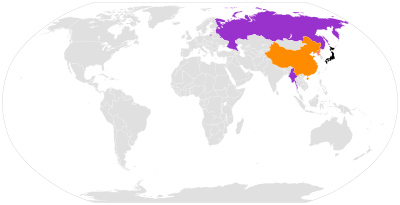Foreign ninja
This article lists non-Japanese people who were ninja, or similar covert agents influenced by ninja.

Strictly, there were very few foreigners recognized as ninja except for legendary figures. However, some other foreign soldiers and agents engaged in infiltration and espionage with Japanese forces.
Foreign-born ninja in Japan
| Birthplace | Original name | Ninjutsu style | Year of arrival in Japan | Name in Japan | Lord | Occupation and achievements in Japan |
|---|---|---|---|---|---|---|
| Ming[1] | unknown | Taisha-ryū | Before 1635[1] | Denrinbō Raikei 伝林坊頼慶[1] |
Sagara Yorifusa→ Sagara Yorihiro [1] |
He was the disciple of renown swordmaster Marume Nagayoshi. Later he became yamabushi and established a ninja corps called Ura-Taisha[1][2] |
Foreign-born kanja
"Kanja"(間者) is the Japanese word for spy. Ninja could act as kanja though their activities were not limited to espionage and ninja sometimes used kanja as their subordinate.
This list includes foreign-born Japanese spies who were not recorded as ninja at that time.
| Birthplace | Original name | Year of arrival in Japan | Name in Japan | Lord | Occupation and achievements in Japan |
|---|---|---|---|---|---|
| Fenyang, Ming |
(Kanji:郭国安) | 1559 | Kawaminami Rishin 汾陽理心 |
Shimazu Yoshihisa→ Shimazu Iehisa→ Shimazu Mitsuhisa |
He made a journey to Japan in 1559. Later he was scouted by Shimazu Yoshihisa, daimyō of Satsuma as retainer. During the Imjin war, he went to Joseon as the officer in charge of letters. However, both Japanese and Chinese sources introduced him as own spy familiar with The Art of War.[3] |
| (Kanji:李達越)[5] | 1587[4] | Kawasaki Seizō[5] 川崎清蔵 |
Nabeshima Naoshige[5][4] | His courtesy name was 宗歓. During the Imjin war, he was active from behind as a Japanese spy.[5] As reward, he was allowed to wear swords and given saraly by Naoshige.[6] Later he became a merchant, and built a town in Saga now called Toujinchō.[4] |
Legendary foreign ancestors of ninja
| Birthplace | Original name | Ninjutsu style | Year of arrival in Japan | Name in Japan | Lord | Occupation and achievements in Japan |
|---|---|---|---|---|---|---|
| Qi | Xu Fu | Iga-ryū | 210BC | Oiro Tayuya 御色多由也[7] |
unknown | According to Iranki, the book of Iga-ryū, ninjutsu was introduced to Japan by Oiro Tayuya who had been traditionally identified as Chinese sorcerer Xu Fu or his fellow.[7] However, his ability seemed to be the method of Xian which affected ninjutsu rather than tactics of espionage.[8] |
According to Bansenshūkai, ninjustu was invented by ancient Chinese hero Fuxi and developed by Yellow Emperor though this account is considered fiction to give authority to ninja.[7]
Also according to Bansenshūkai, The Art of War of Sun Tzu was oldest account of ninjutsu, the art of espionage.[7]
Foreign agents who learned covert methods from ninjutsu practitioners
| Birthplace | Allegiance | Agents | Ninjutsu style | Notes |
|---|---|---|---|---|
| Asano legion | Kōga-ryū | Seiko Fujita, 14th Headmaster or Soke of Kōga-ryū taught arts such as Ninjutsu,Taijutsu in Nakano School.[9] Many students who graduated from Nakano school were the members of a secret military agency in Harbin. In 1937, they established troops for espionage and sabotage composed of Russian exiles such as remnant of Baikal Cossacks and Russian forest police force in Hailin. Those troops were led by Japanese, Russian and Manchurian military officers, and was called Asano legion or Asano butai after their commander Asano Makoto (浅野節).[10] | ||
| Burma Independence Army | Kōga-ryū | In 1941, thirty Burmese independent activists supported by the Japanese empire received military training from a special intelligence unit called Minami Kikan (南機関). Minami Kikan was mainly composed of the graduates of Nakano School. [11][12] |
Foreign agents who have been called "Ninja" but are unrelated to Japanese ninja
See Ninjas in popular culture § Armed groups
See also
- Ninja-Russia relations
- Ninja-Myanmar relations
- List of foreign-born samurai in Japan
References
- "嬉野忍者調査結果 弁慶夢想 (べんけいむそう)".
- "肥前兵法タイ捨流分布 片岡タイ捨流".
- 桃園恵真 (1972). 鹿児島県史料集 第13集 本藩人物誌 (PDF). 鹿児島県史料刊行委員会. pp. 87–88.※PDFファイルの18-19ページ目。
- "40宋歓と唐人町" (PDF). Retrieved 2015-12-03.
- 内藤 雋輔 (1976), 文禄・慶長役における被虜人の研究 (in Japanese), 東京大学出版会,pp.734-735
- 『唐人町の由来』碑
- 山北篤、 福地貴子 (2019-12-14). 図解 忍者. 新紀元社.
- Kawakami Jinichi (2016), 忍者の掟 (in Japanese), KADOKAWA,pp.116-119
- 藤田西湖 (1958). どろんろん最後の忍者. 日本週報社. p. 227–229.
- 西原征夫 『全記録ハルビン特務機関―関東軍情報部の軌跡』 毎日新聞社、1980年
- Bo Min Yaung (1990). アウンサン将軍と三十人の志士 : ビルマ独立義勇軍と日本. 中央公論社. ISBN 978-4121009807.
- John Man (2012). Ninja: 1,000 Years of the Shadow Warrior. Bantam Press. ISBN 978-4121009807.